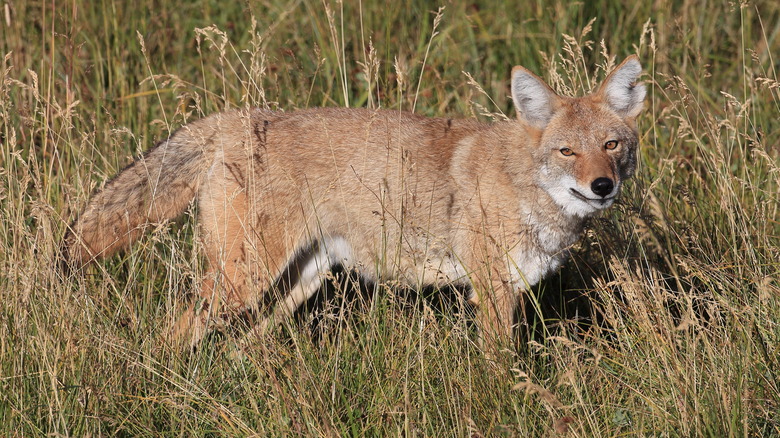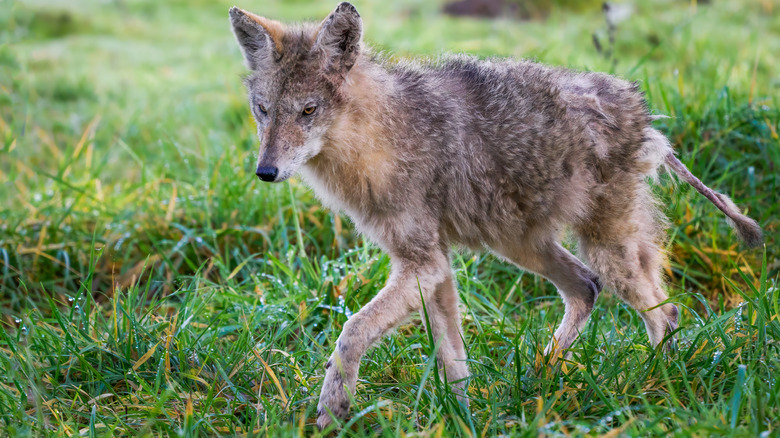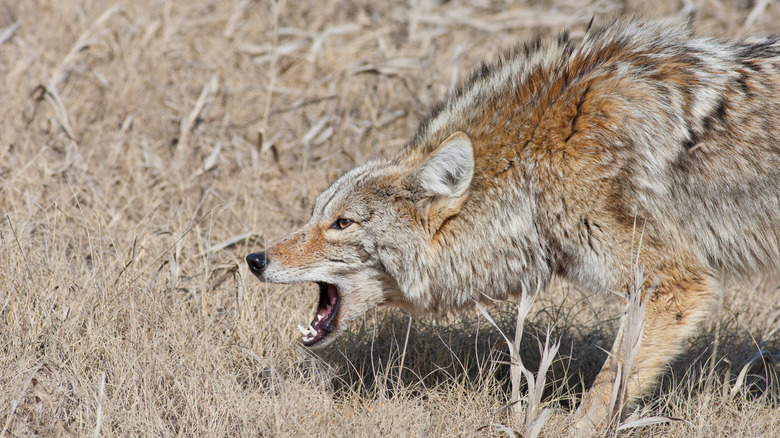What To Do If You Come Across A Coyote On A Hike
The chorus of a pack of howling coyotes is an enduring symbol of the American outdoors. Hearing their shrill cries is often a welcomed reminder that we indeed are living life outdoors. But, what happens if you actually come across a coyote on a hike? Although their natural range once only included the western portions of the United States, Canada, and Mexico, coyotes are now found in 49 of the 50 states in the U.S. (Hawaii being the only exception), as well as in a much broader area of Canada and Mexico. Therefore, if you spend much time hiking or backpacking in North America, odds are pretty good that you will eventually encounter a coyote on the trail.
While they look very much like domesticated dogs, it is important to remember that they are not pets. They are wild animals — although they tend to be skittish by nature and usually try to avoid humans. However, there are times when coyotes can present a danger to people. So, it would be a mistake to go on a hike without first knowing what to do if you come across a coyote.
Stay calm and haze the coyote
When it comes to dealing with humans, hazing is a deplorable behavior. However, if you happen to encounter a coyote, hazing is actually one of the most commonly suggested ways to ensure your safety. In fact, even the Humane Society has a set of hazing guidelines set forth for dealing with coyote encounters. In the event you do come across a coyote while hiking, the first thing to do is stay put — do not run. Fleeing may trigger a predatory instinct in the coyote and turn an otherwise benign incident into an aggressive encounter. Given that coyotes can run nearly 40 miles per hour, you are unlikely to escape if it decides to give chase.
While standing your ground, make yourself look scary to the coyote — raise your hands overhead, scream, holler, throw rocks or other objects. Basically, do whatever you can to scare the coyote off. More often than not, the coyote will scurry away relatively quickly. However, if it does not, slowly move toward it while continuing to gesture and make noise. Do not stop this hazing behavior until the coyote has left the area entirely. Once you continue on your hike, be sure to give the animal a wide berth and continue to scan the area in case the coyote returns.
Aggressive coyotes are cause for concern
If a coyote does not scare off or, even worse, acts aggressively, then that is another matter altogether. This is not normal behavior for a coyote, but it does happen. One of the main reasons for aggressive behavior in coyotes is that they become used to humans and see homes and campsites as areas where they can scavenge food. This is one of the reasons it is important to take steps to protect your campsite. Being infected with rabies is also a reason coyotes may act abnormally or aggressively. Protecting their den is another. However, regardless of the reason or whether you are in camp or on the trail, encountering an aggressive is cause for concern.
Aggressive coyotes typically aren't scared off by hazing tactics and exhibit similar warning signs as domestic dogs — snarling, barking, raising the hair on their back, etc. If a coyote is not showing fear from hazing and/or is acting aggressively, it is best to move away slowly while maintaining eye contact. Give the animal plenty of space and leave the area. If the coyote gets a little too close for comfort, you can use pepper spray (which you should always carry when hiking), throw rocks, or use a stick or branch to shoo it away. Once you have put plenty of distance between yourself and the animal, you should immediately report any encounter with an aggressive coyote to the nearest wildlife authorities.


